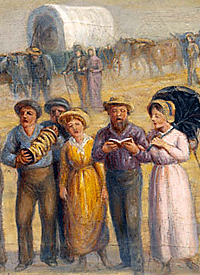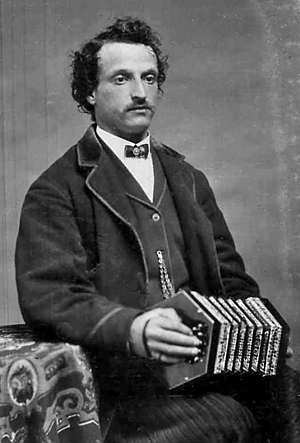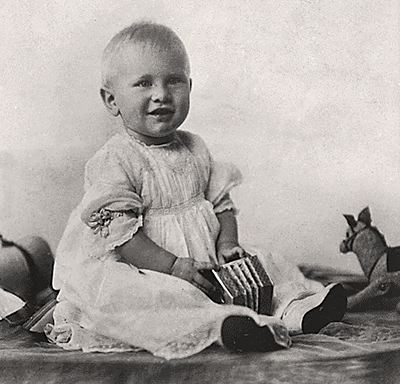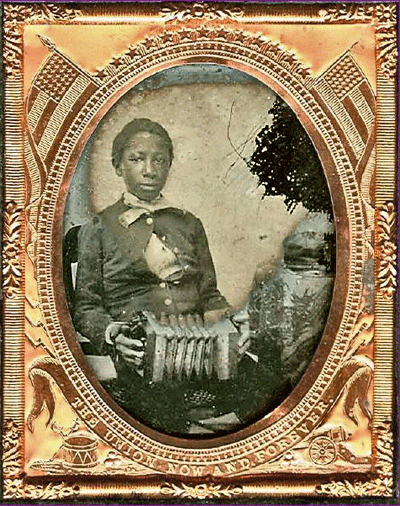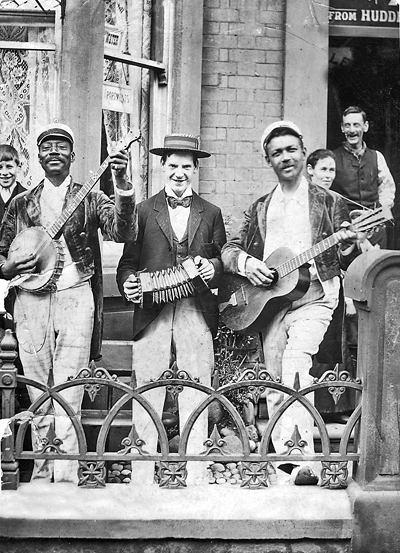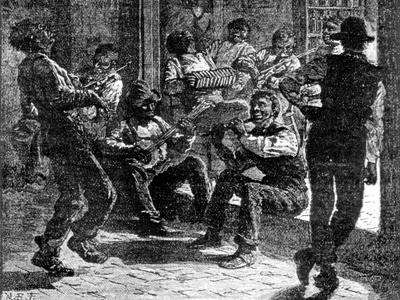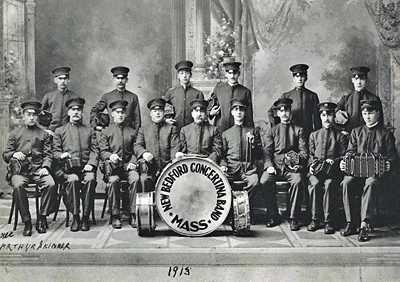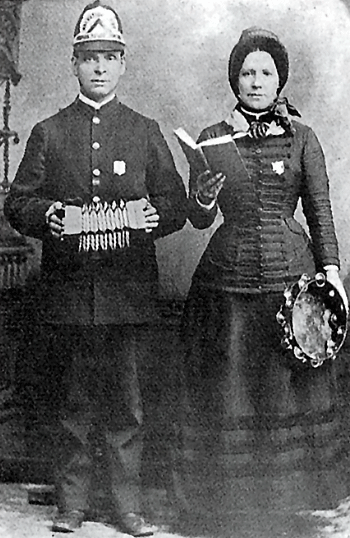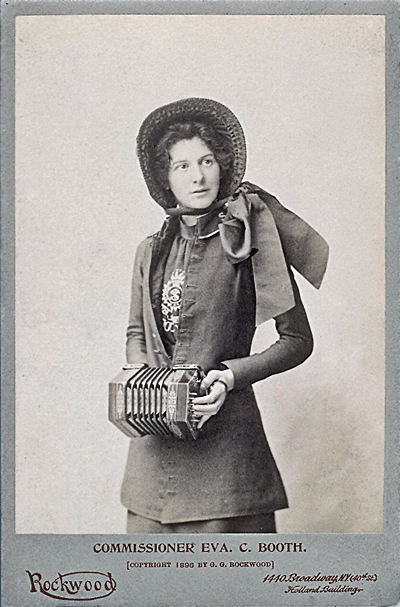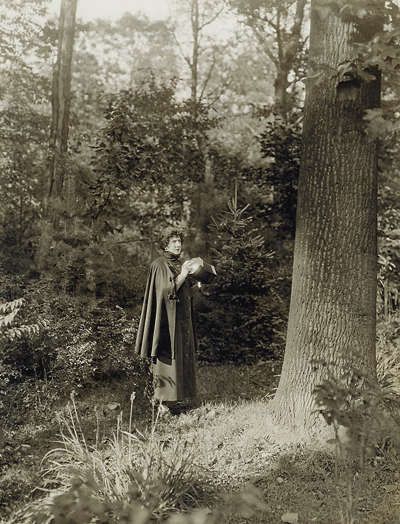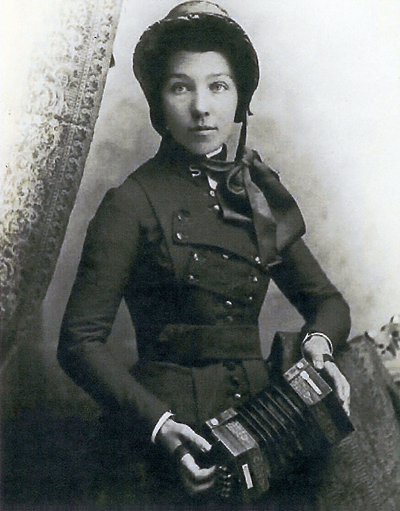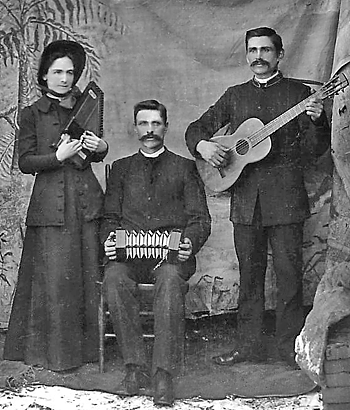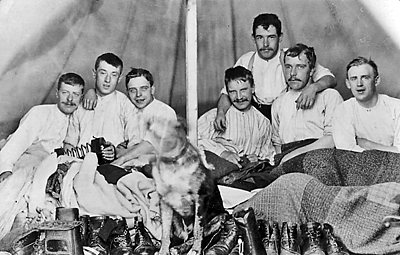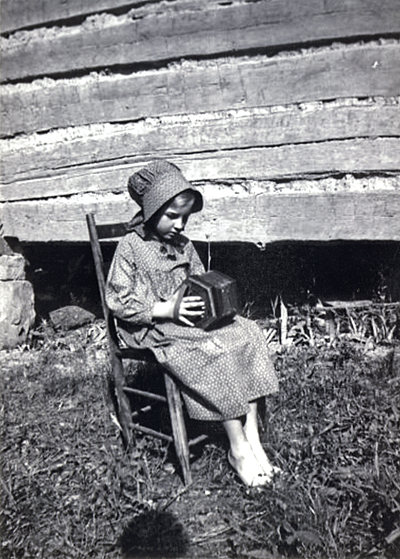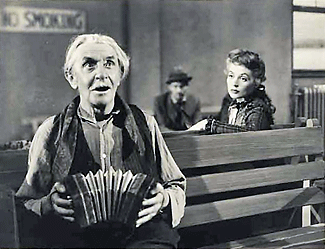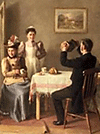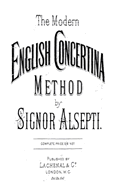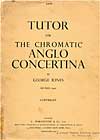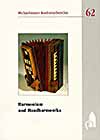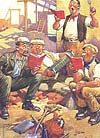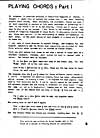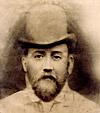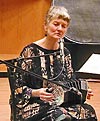Introduction
The Anglo Concertina, or more correctly its direct antecedent the German Concertina,
arrived in the United States by the 1840s, at approximately the same time as in England
and the rest of Europe. It was very popular in middle and late nineteenth century
America, and was extensively played in popular and sacred music of that era. However,
by the early 1900s it had all but vanished from American popular culture, and was played
thereafter mostly by newly-arrived Irish and English immigrants. Its styles of previous
use slipped from living memory without being recorded, unlike England, where small
numbers of players continued to play the instrument into the early twentieth century.
For this reason most current US players are unaware of its earlier American heyday, when
it was far more popular than today. Information on its former use is to be found as brief
footnotes or anecdotes buried in newspaper accounts, in family histories, and in photographs
in archives. This article attempts to weave a basic history of its use in the US from these
scattered and diverse sources.
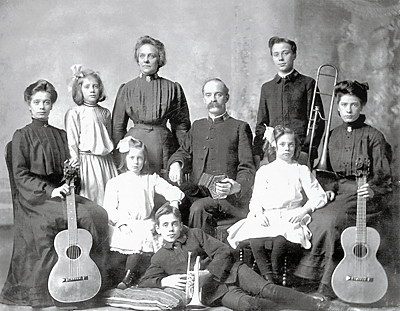
(Click to view a larger version of this picture.)
Figure 1. A musical American family, ca.1885. Note the anglo concertina at the center
of the group as well as the Salvation Army insignia worn by several family members.
From the USA Central Division Historical Museum, Salvation Army, Des Plaines Illinois.
Unlike the more expensive and finely built English concertina, adopted early on in smaller
numbers by the upper crust, the inexpensive, mass-produced Anglo-German instrument was a
working class affair from its inception. Being relatively inexpensive and fairly ubiquitous,
it was owned largely without written comment other than that found in instruction manuals,
much as one would own a ukulele in the 1920s or an electronic keyboard today. Because most
of the musical and social press coverage of the day was tilted toward the ‘respectable’ upper
echelons of society, any serious accounts of musical performances on the concertina usually
involved the English system instrument, which was typically played in more elegant settings.
Modern audiences will enjoy a performance of traditional dance music by a group such as
The Chieftains in a large concert hall, and read a glowing review about it in the next morning’s
newspaper. Such was not the case in the nineteenth century, where the press take on such ‘common’
music, played on an Anglo-German concertina, was typically dismissive. It is from this social
context that we must piece together the anglo concertina’s story in America.
Anglo Terminology
The variety of names applied to the Anglo concertina reflects the instrument’s multifaceted
history of development. The ‘German concertina’ was invented in 1834 by Carl Friedrich Uhlig,
in Chemnitz Germany. He seems to have been unaware of the development of Sir Charles Wheatstone’s
English system concertina only a few years earlier.2
The first one-row single action instrument
had a diatonic scale and ten buttons, and was soon improved to two rows with twenty buttons.
This square-ended wooden instrument was mass-produced in Germany and exported widely. By the 1850s,
English manufacturers had built their own improved version of it with better reeds and action,
calling the resulting two-row instrument the ‘Anglo-German concertina’. English maker George Jones
added a third row of keys, calling it the ‘Anglo-Chromatic concertina’. German builders soon copied
the hexagonal ends used by English makers, and both countries have built and exported Anglo-German
and Anglo-Chromatic instruments to the present day. Because the German-made models were less expensive
and more readily available in the U.S., they were more popular, although both English- and German-made
instruments were played. Figure 2 is a copy of an American tintype from about 1870, showing a man holding
one of these inexpensive, German-made Anglo-German concertinas. Although sometimes confusing, the term
‘German concertina’ tended to be used for any two-row German-made concertina, no matter whether square
or hexagonal in shape. In the following discussion, the term ‘anglo’ with a small ‘a’ is used generically
for the entire class of single-action, two- or three-row diatonic concertinas; where a distinction is to
be drawn, the various other terms will be used.
The keyboard used in the first German concertinas continued to evolve in Germany on a path that
diverged from that of the anglo. Carl Uhlig and others added more buttons and more rows, soon
producing the large, square-ended ‘Chemnitzer concertina’. This instrument was and is popular
amongst members of German and Polish communities in America. A full account of it is use is beyond
the scope of this report, but has been extensively documented by James Leary.3
Arrival and Early Distribution in the US
The date of arrival of the first anglo in the US is not precisely known, but by 1846 a first tutor
for the German concertina had been published by Elias Howe (The Concertina Without a Master), the
same year that a first tutor for it had been published in England by Carlo Minasi (Instruction Book
for the Use of Learners of the German Concertina).4
The period from the late 1840s to about 1900 was
the heyday of this instrument in the US; during this period at least twenty-three anglo tutors were
published in the US, versus only three for the period from 1900-1950, and only four during the period
1951 to 2006.5
In the 1860s and 1870s, German and Anglo-German concertinas seem to have been more popular than
accordions and English concertinas. For example, the U.S. Board of Music Trade’s Complete Catalog
of Sheet Music and Musical Works of 1870 listed 11 tutors for the German concertina versus only
three for the English concertina and six for melodeon.6
Figure 3 shows an advertisement from an
1868 New York City music merchant that lists four German tutors for sale to only one for the EC.
This ad was reproduced many times over many months, and shows that German concertinas were his
shop’s main musical instrument.
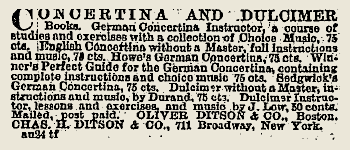
Figure 3. Advertisement for tutors for German and English concertinas, 1868.
From the Brooklyn (New York) Daily Eagle, December 14, 1868,
searchable online.
German steamships brought inexpensive German-made concertinas to America in huge numbers. When one of
these steamers, the Grasbrook (Figure 4) was wrecked off Newfoundland in the early 1890’s, it was
said that ‘German concertinas appeared in every house in a whole countryside’.7
A report of the
US Congress on the subject of tariffs on imported goods in the year 1869 had only two listings
under the heading, ‘Musical Instruments’: ‘Concertinas’, and then all other ‘Musical Instruments’,
underscoring the Anglo-German concertina's primacy as one of the earliest mass-produced and
mass-purchased musical instruments;8
a similar report for 1899 mentions the ‘large sale of German or Austrian concertinas’.9
A list of
declared imports from Germany for 1900, at the end of the anglo’s U.S. heyday, listed 94,650 concertinas
and accordions for that fiscal year alone.10
It seems plausible that total imports of German concertinas
over the period 1846-1900 may have reached into the hundreds of thousands or more. These quantities were
vastly higher than the output of the main English firms Wheatstone and Lachenal, which represented
the higher quality end of the concertina trade.
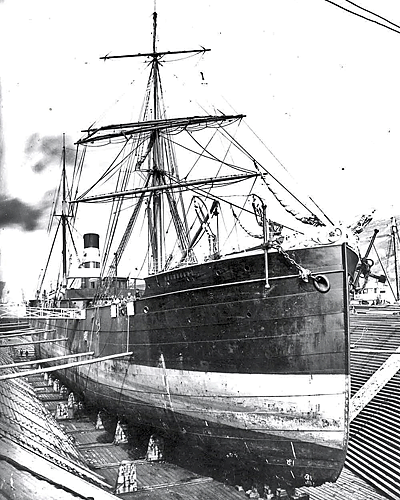
(Click to view a larger version of this picture.)
Figure 4. SS Grasbrook, a German steamship, in drydock in Newfoundland, 1885.
This vessel carried large numbers of German concertinas to North America.
From the online archives of the Memorial Library, University of Newfoundland.
Period newspaper advertisements show that Anglo-German concertinas flowed to all parts of the country,
even to areas not yet reached by train. Some of the earliest include Brooklyn New York (1868),
New Hampshire (1869; ‘ten-keyed concertinas for one dollar’ in The Sentinel), New Jersey (1870),
New Orleans Louisiana (1867), San Antonio Texas (1867), Galveston Texas (1869), Idaho (1870). When
mail order catalogs became popular in the late 1800s, both German and English-made Anglo-German
instruments were carried (Figure 5).11
A one-row German concertina could be had for about $1.00
in the late 1860s, and a two-row for about $5.00 by the 1880s. English-made anglos went for a
premium of about $11.00; see Figure 5.
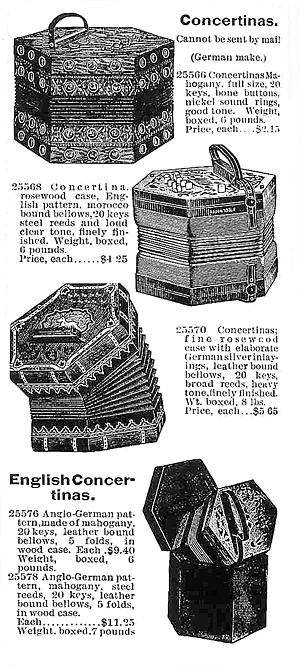
(Click to view a larger version of this picture.)
Figure 5. Anglo concertinas in the Montgomery Ward Catalogue of 1885. No English system
concertinas were included; the term ‘English concertinas’ refers to English-made anglos.
From the Dover Press facsimile (1969).
The anglo has retained its very large edge in popularity over the English system instrument in the
US to the present day, but its early lead over the accordion was not to last. By 1880 or so,
entries for free reed instruments in mail order catalogues such as Montgomery Wards show that
accordions overtook the Anglo-German concertina in overall sales and popularity in the last two
decades of the nineteenth century, although the anglo still remained popular with the general
public until the early decades of the twentieth century (see discussion below).
Anglo vs English Concertinas: Music on the Social Ladder
The English system concertina arrived almost simultaneously with the anglo, and its first
documented public appearance was at a concert in Charleston South Carolina on May 3, 1845, where
the ‘Hughes Family’ performed on harp, violin and concertina.12
By 1851, regular performances of
classical and semi-classical music were given in New York by Alfred B. Sedgwick (1821–1878),
Robert Thompson Spice (b. 1846) and by others, in polite soirees and balls.13
Sedgwick wrote several
classically-oriented tutors for the English system instrument, the first of which was published in 1854:
‘There is no instrument as yet invented that presents so many advantages to the Amateur, as the
Concertina … one of those destined to continue alike popular in the Concert or Drawing room …. To
ladies it is particularly recommended for its extreme elegance and portability, as also on account of its
being the only wind instrument at their command’.14
Sedgwick disdained the more common German concertina,
however: ‘The English concertina is … far superior … to that known as the German concertina, which
as compared to the former, can only rank as a mere toy’.15
‘Toy’ or not, the anglo was arriving in vast
quantities from German factories, far out-stripping the numbers of imported handmade English system
concertinas. In a bow to this mass popular audience, Sedgwick also published instruction manuals for
the German Concertina, beginning in 1865 (Figure 6). In his introductory comments, Sedgwick
commented: ‘… although inferior in all respects to the English concertina … it is capable of producing … a much
better class of music than has been generally supposed’.16
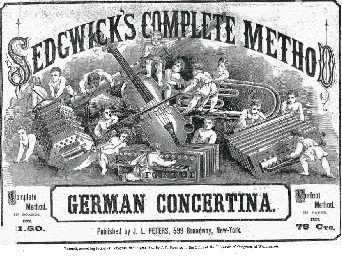
Figure 6. German concertina tutor by Alfred Sedgwick, 1865.
From Randall Merris, Bibliography,
Anglo Concertina (A74).
Thus began a social divide between users of these two instruments
that persisted throughout the nineteenth century in the US.
Whereas the English system was
favored in the parlors of well-to-do Americans,
the much less expensive anglo was owned by ‘working class’ folk,
was played in dance halls and in the street, and was subject to the condescension of the elite. American
newspaper accounts of the day were quick to praise appearances by Sedgwick and other classically-oriented
English system players, but tended to be very critical of the ‘rougher’ popular music that was typically
played on anglo concertinas in dance halls, minstrel shows, and tent revivals,
which included popular songs, sacred hymns, and what would
today be termed ‘traditional’ dance music. In an 1877 review of a recently concluded free open-air classical
music concert in New York City
where large numbers of the general public attended, it was reported that ‘The result of this
[free concert] … has been to simulate a taste for good music among many of the lower classes who
attended … and to make them abhor those tunes which are nightly heard on the concertina’.17
This echoed the
sentiment of an English observer who wrote, ‘The German concertina is admittedly an inferior instrument.
Still, we must not sneer at the thing. I believe it does give a measure of enjoyment to some of our hard
working people; it is better for them to listen or to dance to a German concertina than to hear no music
at all. In time they will learn to like something better’.18
In another day and time, it is possible that the social distinction between users of the English
concertina and the anglo would not develop in such a strong and clear-cut manner. In mid-nineteenth
century New York City, however, the instruments arrived at a time of increasingly acrimonious dispute
between those Americans with aristocratic sentiments and the rapidly growing working and immigrant masses.
Class warfare in the New York entertainment world erupted in 1849 in the Astor Place Riots, where the petty
squabbles between two Shakespearean actors (one an aristocratic Englishman, the other a Bowery-based American
with a broad popular following) incited street riots where over 30 persons died. It has been said that, ‘After
the Astor Place Riot of 1849, entertainment in New York City was divided along class lines: opera was chiefly
for the upper middle and upper classes, minstrel shows and melodramas for the middle class, variety shows in
concert saloons for men of the working class and the slumming middle class’.19
It was into this simmering
cauldron that the two relatively new instruments, English and Anglo-German, arrived, and they soon found their
respective places on the social ladder.
An Instrument with Mass Appeal
Anglo concertinas were very well served by numerous tutors of the period, and these contain much information
about what sort of music was played on them.20
Figure 7 shows the cover of an 1883 German concertina tutor by
prolific music publisher Septimus Winner of Boston, who prepared five tutors for this instrument between 1869
and 1897, and Figure 8 shows a cover for an 1879 tutor by Elias Howe. The music contained in Elias Howe’s
German Concertina tutors contained what would today be called ‘traditional’ music: ‘The Very Latest and Best
Songs, Polkas, Galops, Quicksteps, &c’21,
as well as waltzes, marches, and ‘Contra and Fancy Dances’.22
Howe marketed to the masses, and although his extensive catalog of instruction manuals catered to a wide
variety of instruments (including manuals for brass instruments, violin, German Accordion, French Accordion,
flute, flageolet, clarinet, piano, and guitar), he did not focus on classical music, and did not carry tutors
for the English system concertina.23
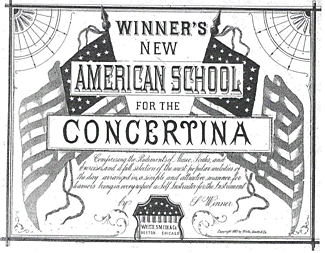
Figure 7. Concertina tutor by Septimus Winner, 1883.
From Randall Merris, Bibliography,
Anglo Concertina (A96).
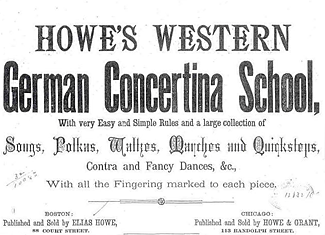
Figure 8. German concertina tutor by Elias Howe, 1879.
From Randall Merris, Bibliography,
Anglo Concertina (A36).
Anecdotal evidence underscores the popularity of the concertina with the working class.
Much comment in the newspapers was negative, as was
this piece from the Connecticut Constitution in 1869, complaining of urban street noise: ‘No one interferes to
stop any account of noise in the night and early morning …. At any hour of the night a fool in love with a concertina
may disturb the whole neighborhood with noises he pleases to think music …’.24
A police justice in Jersey City,
commenting on ‘a complaint of disturbing the peace, by the use of a so-called musical instrument at a late hour
at night, pronounced this eminently humane judicial opinion: “Any man who will play a concertina on a stoop at
11 o’clock at night deserves the severest punishment the law allows. I think he ought to be sent to the State
prison for five years” ’.25
The concertina often appeared within the crime pages, either as a stolen instrument ranking high on the
list of treasures taken from an apartment, or as connected somehow with a domestic crime.
A typical account from 1889 involves a burglary of a household where the thief removed ‘a boys overcoat, a concertina,
an accordion, a pair of opera glasses and some small articles …’.26
In the days before recorded music, electronic stereos, televisions and mass-produced household appliances, items like concertinas and accordions
were among the most prized items a working class family might own; such instruments provided the day-to-day music
that people heard most. In an 1859 investigation of wife abuse, a male friend of the accused spoke up for his
friend, saying, ‘As soon as they got in the ‘ouse, Mrs. Boyce threw a concertina at his ‘ed, and locked the door
and ‘ollered murder’.27
In a similar domestic incident, a Polish-born defendant was ‘… deserting his wife, but
before taking his departure he destroyed all the furniture he could not conveniently remove [by throwing it out
the tenement window], beat his wife, and sat down amid the wreck and played his concertina’, before an arriving
officer arrested him.28
In Hazleton Pennsylvania, 1895, ‘Joseph Washkovitch died at the hospital from a broken s
kull. Last Friday he played the concertina at a Hungarian dance, and because his music was unsatisfactory,
John Lapka struck him in the head with a beer bottle’.29
The frequency of appearance of concertinas in such descriptions indicates that they were commonplace (and
sometimes mistaken for accordions by careless reporters). In a tightly-packed urban environment, they had the
same effect on those requiring peace and quiet as a noisy boom-box playing hip-hop music
on a bus would today,
as the following bit of doggerel from an 1894 New York City newspaper30
demonstrates:
The New Angel
Now John was young and gay and free
And mainly proper in demeanor,
But lackaday, one fault had he—
He would play on the concertina.
By day he played, and eke by night;
Played sometimes slow and sometimes faster,
He played by ear and played by sight,
And at his music was a master.
The neighbors near his dwelling place
Became a-weary of his playing,
And each, with anger in his face
Declared that John was ripe for slaying.
But others sought the aid of law
And served on John the law’s subpoena,
And while he pondered it with awe,
Stole in and took the concertina.
He sought it high, he sought it low,
And of each friend in vain inquired,
And then at last, o’erwhelmed with woe,
Took to his bed and there expired.
He soared aloft in heavenly flight,
With spirits calmer and serener,
And asked St. Peter if he might
Exchange his harp for concertina.
Life often imitates art, as in this real-life account from an 1897 newspaper: ‘In Cleveland, some one
broke into a house and stole a concertina and nothing else. It is thought some weary neighbor was the
burglar’.31
Not all references to open-air concertina playing were negative, by any means, as this
description from a turn-of-the century Biloxi Mississippi newspaper indicates: ‘And in the still night
air, from the stifling room of the tenement, floats the sound of the concertina, now clear and distinct,
resolving itself into the familiar strain: ‘There’s No Place Like
Home’’.32
The concertina was frequently mentioned in other public settings in a way that demonstrates that the
instrument was somewhat iconic in addition to being commonplace. One of President Grover Cleveland’s
generals, in the presence of the President, likened him to a concertina: ‘… the free trade men can take
hold of one handle and you go to them, and the high tariff men grasp the other end and you yield to them.
I don’t know of anything that you resemble more than a concertina. Pull it in and out and at either end,
or at both ends at once, and it is equally pliable’.33
Thirty years later, a future president would be
photographed as an infant with a concertina at his feet (Figure 9).
The Anglo on the Way West, with Mormon and Other Pioneers
From 1846 to 1869, more than 70,000 Mormon pioneers made the trek west from Nauvoo, Illinois to Great Salt Lake,
Utah, using oxen-drawn covered wagons and man-powered pushcarts. Many were immigrants from England, Wales,
Scotland and Ireland, and some of them brought their concertinas with them,
along with fiddles, wooden flutes, and melodeons, as they emigrated by sea and then
overland.34
Fanny Fry Simons, who immigrated in 1859, sailed
aboard the William Tapscott and recalled that there was ‘dancing and music every evening, with a very few
exceptions’.35
John McAllister, who was a Latter-day Saint passenger aboard the Manchester in 1862, recorded: ‘Saints on deck dancing,
singing, knitting, sewing, etc. Violins and concertinas in full blast’.36
The instrument was already popular in
the US at the time of the Mormon migration, and native-born American converts would have purchased theirs locally.
A nineteenth century painting by George Martin Ottinger (1833-1917) entitled
Immigrant Train: Away, Away to the Mountain Dell (Figure 10)
depicts a group of singers and musicians performing a hymn next to a wagon train as it passes through the desert near
present day Chimney Rock, Wyoming. The detail (Figure 10a) shows a flute player and an anglo concertinist among the
singers. Ottinger was a Salt Lake City artist who himself migrated to Utah with his mother in an immigrant
wagon train in 1861. This painting is one of a series of his works that depict the Mormon migration;
it was based upon the artist’s personal experience. Of these
migrating groups of Mormons, it was said that ‘In most groups there was nearly always one person who played the
concertina, harmonica, or violin, and so they often had accompaniment for group singing and
dancing’.37
In one
such account, the oldest living son of early Mormon president Heber Kimball recounted, in his old age, that
danceable tunes were often in short supply in the early days of the migration,
and ‘related of having danced (using) sacred music. The accompanist on a concertina knew only two tunes,
‘Oh My Father’ [which was] used for quadrilles, and for waltzes, ‘Come, Come Ye Saints’’.38
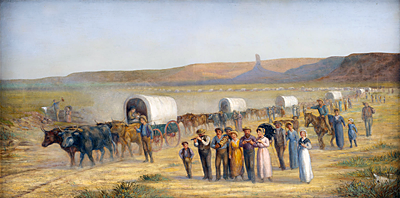
(Click to view a larger version of this picture.)
Figure 10. The Immigrant Train: Away, Away to the Mountain Dell (1897),
by George Martin Ottinger (1833-1917); Ottinger was depicting a wagon train
of the sort that he himself used in traveling to Utah in 1861.
Reproduced by permission of the Springville Museum of Art, Springville Utah.
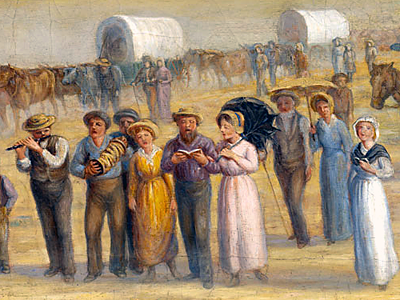
Figure 10a. Detail, The Immigrant Train: Away, Away to the Mountain Dell (1897),
by George Martin Ottinger, showing a group of singers and musicians
that included an anglo concertinist.
Reproduced by permission of the Springville Museum of Art, Springville Utah.
As most of the Mormons were people of modest means, German and Anglo-German instruments would have been the most common
(such as the one depicted in Figure 10), although English system instruments were also
played.39 In 1862, a concert at
the then-new Mormon Tabernacle in Salt Lake City boasted two hundred vocal and instrumental performers in a popular
concert that included ‘Anthems, Quartettes, Trios, Duets, Songs, Readings, Pianoforte, Harmonium, and Concertina Solos’.
Like the performers, all of the musical instruments mentioned made their way west by covered wagon, as the
transcontinental railroad did not arrive there until 1869.
Some of these pioneers were also active in the Indian Wars, and at a reunion in 1907 for aged veterans of those wars
one W.D. Major ‘had the honor of leading on his celebrated concertina. The people there were so kind that they preferred
not to take their money back which they paid him for his services’.40
Evidently, advancing age commanded more respect,
because at a similar gathering of veterans of the Indian Wars four years later ‘the number that received the most applause
and an encore was a selection on the concertina played by the old veteran, W.D. Major’.41
John Jarvie, a Scotsman, settled in sparsely populated Browns Park Utah in 1880 (Figure 11). He operated the general
store and trading post and was ‘much in demand at social functions because of his musical talents on the organ and
concertina’. He was acquainted with Butch Cassidy and the Sundance Kid of the Wild Bunch as well as several other
outlaws who frequented his trading post, and met his death in 1909 when he was robbed and murdered in his store.
His killers placed his body in a boat and pushed it out into the Green River.42
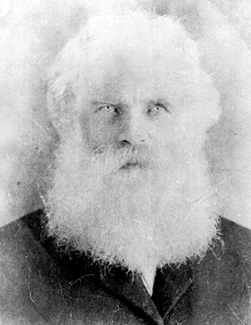
Figure 11. John Jarvie, a pioneer trading post owner and concertina player
of Brown’s Park Utah.
From online archives of the Marriott Library, University of Utah.
Anglo Use During the War Between the States, and in Minstrelsy
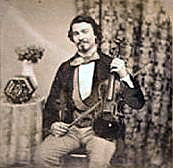
Figure 12. Musician with violin and Anglo-German Concertina.
From an early stereoscopic photograph, ca. 1850s.
An early photo (Figure 12) shows a musician with two prized instruments: a fiddle and an Anglo-German concertina.
While most musicians today would consider his mass-produced two-row Anglo-German concertina as an inferior instrument
to a modern, more finely-made anglo or to a good violin, the German-made instrument was a novelty in its early years
and is here exhibited with considerable pride of ownership. The German and Anglo-German concertinas were known and
played by soldiers in the Civil War, although not nearly as often as various types of flutes, brass and stringed
instruments. A Union spy named William Passmore wrote in 1862 of an event at the docks of Liverpool in neutral England
when the Confederate raider Alabama was being re-supplied. He reported that he ‘met the seamen … coming down Canning Street
from the ship, playing ‘Dixie’s Land’ on a fife, concertina, and cornopeon [cornet], and they all took the … Woodside [ferry]
boat for Liverpool. They still kept playing ‘Dixie’s Land’ on the ferry
boat’.43 In the tintype photo of Figure 13,
a black youth in military-like garb holds an early square-ended German concertina; the frame with its Union sentiment
establishes its Civil War vintage.44
Anglo concertinas were also played in minstrel shows, the fore-runners to vaudeville and the music halls. Figure 14
shows one unnamed group, whose instrumentation consisted of tambourine, Anglo-German Concertina, bones, and banjo.
John F. Fields (born 1853) and William F. Hoey performed together as blackface musicians; Fields played an
Anglo-German concertina (Figure 15). After a performance at the Park Theatre in New York City in 1877, it was
reported that ‘The two … performers manage to sustain an air upon half a dozen different instruments during the
execution of some difficult salutatory feats, all of which convinces the gallery that a great deal of muscular energy
is needed for the perfect illustration of high art’.45
An 1875 Minstrel entertainment in New Orleans as well as other
towns in the South included an appearance by John D. Kelley, of whom it was said that, in addition to playing barnyard
sounds on the violin, he ‘played ‘Home, Sweet Home’
on the banjo and the concertina at the same time, playing the air
with the concertina and accompanying it with the banjo, which is very
difficult’.46 In 1892, the Primrose and West
minstrels included performances in Omaha by ‘Musical’ Dale, who ‘showed what he could do with hand bells, concertina,
banjo, and a few strings of sleigh bells’.47
A minstrel act in an 1897 North Dakota appearance included musicians Baker
and Tuttle on ‘banjo, guitar and concertina’.48
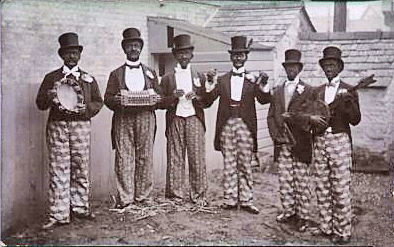
Figure 14. Blackface minstrel troupe, ca. 1870-1880.
A concertina player stands second from the left.
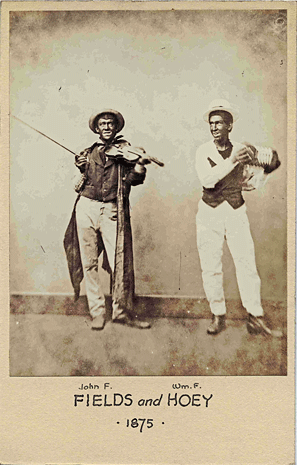
(Click to view a larger version of this picture.)
Figure 15. William F. Hoey and John F. Fields, blackface minstrels
and music hall performers, 1875. The concertina player is John Fields.
From the archives of the Harry Ransom Humanities Research Center,
the University of Texas at Austin.
Many concertina players of today who utilize top-of-the-line handmade or intermediate grade hybrid instruments may find it
difficult to believe that these humble German-made concertinas were up to playing dance music in such professional performances,
even though period concertina tutors such as those of Elias Howe contain many such tunes. Although there are no recordings
of the Anglo-German concertina players of this period, a good idea of the capabilities of the instrument for traditional
dance music can be had by listening to a recording of Micho Doyle, of County Clare, Ireland, made in the
1960’s.49
These inexpensive German-made instruments were commonly played in Ireland until recent, more prosperous times, and the cited
recording shows the speed and drive possible for it in skilled hands. In the mid-nineteenth century the Anglo-German
concertina was an exciting novelty with its mechanically-made music, and there were no instruments of better quality
available to most players to which it could be unfavorably compared.
Late in the nineteenth century and extending into the twentieth century, vaudeville replaced the minstrel shows as
entertainment moguls sought to develop a wider, multi-class audience; in effect, healing the class divisions in the
American entertainment world that resulted from the Astor Place riots half a century earlier. In vaudeville, the
concertinas of choice became the English and Duet systems, with their greatest stars being the
German dialect comedians Dutch Daly and Joseph Cawthorne. Dutch Daly sometimes used a miniature anglo concertina
in his act.50
Although in a minority in this type of venue, anglos doubtlessly were used in some other vaudeville
and music hall acts as well. For example, Wheatstone records show that a set of three unusual, twelve-sided Wheatstone Edeophone
anglos was built in 1934 for a team of concertina-playing acrobats in
Cincinnatti.51
Figure 16 shows an group of three
turn-of-the-century street musicians; although the provenance of the photo is not clearly known, the word ‘Apartments’
in the sign in the window suggests an American setting, as the term ‘Flats’ would be the more common usage in Britain.
The cut-away jackets worn by the African-American banjoist and guitarist indicate that these two belonged to a professional
group. The different dress of the anglo player (and the spontaneous delight on the faces of the passers-by) may indicate
that he was only jamming with them in the street,
or the three may have together constituted a variety show or
vaudeville ‘act’.52
Anglo Use by African Americans
The concertina was not unknown to black musicians of the 19th century, as the photo of the Civil War era black youth
in Figure 12 has shown.
Figure 17, taken from a late 19th century newspaper, shows that the concertina was used in
early black string band music as well.53
In this evocative drawing, a banjo player is at the center, flanked by
two fiddles, a flute or fife, and a concertina. A search of available archives has revealed not much in the way
of narrative documentation.
It is well known that the distinctive ‘back-beat’ rhythm
of the “Old Time” string band musical style originated in the 18th and early 19th
century with enslaved black musicians, who played the English and Irish tunes of their masters during plantation
and other social dances, but with a distinctly African rhythm.54
The blacks also, of course, introduced tunes from
their own backgrounds. A further development of the genre came when white musicians began to play
using that rhythmic style in
minstrel bands and in later “Old Time” string bands. Figure 17 documents the place of the
anglo concertina as an occasional accessory in this style.
The preferred free reed instrument amongst 19th century black musicians was the accordion however, according to
Jared Snyder.55
Among others, Leadbelly played a melodeon, and some of his recordings erroneously call
it concertina music, as Snyder has pointed out. In the 20th century, Willie Green was one of the most respected early
Zydeco players (the music was then called ‘la la’). He moved to Houston Texas in the 1920s and began playing
professionally in 1949. Green occasionally used a concertina instead of his button accordion, playing a mixture
of Cajun and blues tunes.56
Excepting the prominent use of accordions in Cajun and Zydeco music, no bellows-driven free reed instruments have been
particularly popular with black musicians after the late 19th century.
Anglo Use in Nautical Contexts
The appearances of the concertina in the Confederate Navy and in trans-Atlantic ships carrying Mormon passengers
from England (see above) are just two of many documented appearances of concertinas in ocean-going vessels during
the late 1800s. American travelers were often exposed to concertina music played by sailors on civilian steamships
plying the trans-Atlantic passage. On the City of Chester
(Figure 18), owned by the Liverpool and Philadelphia Steamship Company
(later called the Inman Line), American passengers in an 1878 crossing ‘paid a visit to the forecastle, sailor’s quarters … where
the jolly tar spins his yarn, and sings his song, one playing a jig on a concertina while others
danced’.57 On the City of Brussels
in an 1880 passage, ‘Stewards furnished music on a concertina and banjo suitable for square and round dances …. The evening’s
festivities closed at 10 o’clock with the Virginia reel …’.58
In an 1898 article entitled the ‘Making of the United States
Man-o’-Warsman’ in the Dallas Morning News, it was noted that the trainees’ leisure time was spent ‘playing cards, some
in athletic games, some with concertina or violin, some in smoking or
‘yarning’ ’.59 In another Naval training ship
in a South Carolina harbor, it was noted that after an order was given, ‘away forward down in the recesses of the quarters,
a concertina stopped automatically in the middle of a plaintive note, and presently the boys came
tumbling up’.60
Concertinas were also played on river vessels; in an investigation following an 1891 collision of two brick barges
in a New York City river in which twenty persons drowned, bargeman W.C. Curran allowed that ‘We were playing a concertina
in the cabin at the time of the accident’.61
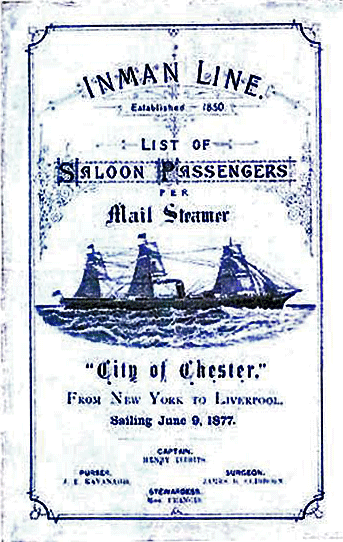
Figure 18. Passenger’s brochure of 1877 for the Inman Line steamship City of Chester,
where concertina-playing ‘tars’ entertained passengers during the trans-Atlantic run.
Courtesy of www.clydesite.co.uk.
Anglo Use by Immigrant and Other Ethnic Groups
Inexpensive Anglo-German and German concertinas were extraordinarily popular with immigrant groups, and
many became familiar with the instrument at their first landings in New York boarding houses: ‘At the
boarding houses there is considerable sociability, plenty of concertina and flute music, with a dash of
semi-barbaric melody from some unnamable instruments played by the Hungarians’.62
It is not known how many Irish immigrants played concertinas in the nineteenth century, but clearly some
did. In an 1894 meeting of the new ‘Irish Musical Union’ in New York, it was stated that ‘The object of
the union is to revive and preserve Irish music. The present membership includes pianists, violinists,
flutists, and concertina players’.63
The great Chicago music collector Francis O’Neill, however, had
scarcely a mention of concertinas in his numerous nineteenth century works; this may be due to the fact
that, as a proud piper, lowly concertinas were of little interest to him. Or perhaps they were just too
new; for example, electric guitars are today mostly unwelcome in Irish music.
An 1880 crime report noted that ‘George Lieb stole a concertina worth $80 from a house in which John O’Neill
resided; (he) sold it for $1.50’.64
It seems that the Irish penchant for top-of-the-line English-made anglos had already begun.
Perhaps the best indication of nineteenth century Irish immigrant concertina playing can be found in the following
newspaper account of the travails of one Paddy Ryan in the seething immigrant jungle that was New York City in 1888,
entitled ‘Where Ignorance is Bliss’.65
It demonstrates the position of the concertina in immigrant Irish society at
the time:
Although it is nearly a century since the tune of ‘Croppies Lie Down’ was sung by Orangemen in Ireland while
they massacred the Catholics, it still has the power to incite Irishmen to overt acts. Paddy Ryan plays the
concertina. He was born in this city. He had somewhere heard the obnoxious tune but knew nothing of its historical
significance. Paddy is a member of an East Side social club. The annual ball of his society occurred a few evenings
since. The usual fiddle scrapers were on hand to provide the dance music but Paddy had brought his concertina along,
being a little proud of his one accomplishment. During one of the lulls between the dances the president of the
association went up to the boss musician and said: ‘Av ye plaze, sor, I wouldn’t be wantin’ t’ be interf’arin’
wid your music. Sure, we’re all highly plazed wid it, so we are, an’ more power t’ yer elbow when yer waggin’ yer
fiddle bow. Faix, ye’ll get yer pay whether or no, so ye will, an’ its not wan o’ us ‘ud be takin wan cint off yer bill’.
There he stopped to take a breath and the German professor looked down at him from the platform in an enquiring way.
‘Vot you will haf, mine frent? Beer, ha?’
‘Go smother yersel’, ye cheese-headed Dutchman. I can buy me own beer, so I can, an small fear t’ me. I want
ye t’ stop squ’akin’ th’ fiddles an’ rattlin’ th’ brass till Paddy Ryan plays an Irish chune on his concertina.
Now, d’ye understand that, ye ould beer barrel’?
‘Yah, yah, das is all recht. Stop de moosic’.
The music was stopped and the president shouted: ‘Will Paddy Ryan come up [to] the platform an’ play an Irish chune
fer the b’ys an’ gur-rls’?
Paddy came bashfully forth, his face suffused with blushes and his beloved concertina under his arm.
‘Play the ‘Rakes o’ Mallow’’, shouted a voice.
The rollicking air set everybody’s feet to itching. This was followed by ‘The Wind that Shakes the Barley’, ‘The
Cat in the Corner’, and ‘The Limerick Races’. All these were rapturously received. Paddy was encouraged. He glowed
with pride. Pulling his forelock apologetically, he stood up and said:
‘Av the ladies an’ gintlemin plaze, I’ll play a new chune I’m after larnin’ the other day’.
Of course the audience was pleased, and every ear was open to catch the air. Paddy pulled the lively measures
out of his instrument with eagerness. He had hardly played two bars, however, when the listeners turned and
looked at each other with surprise and indignation. Then twenty roysterers arose as one man and made a rush
for the luckless player. They seized him from behind and before. They kicked his concertina into the middle
of the floor, where the girls made a football of it. They tore his store clothes from his back and bruised
his cheeks with their hard fists. Those who could not get at him shook their fists in his direction and swore
terrible oaths. Impelled by a stogy boot poor Paddy shot out the door, followed by the howling mob. As he
rolled down the staircase and out on the sidewalk, a friend picked him up and hurried him around the corner
into a saloon. Bleeding, bruised, and almost naked, Paddy stammered:
‘Shure, w-w-w-hats th’ matter, Jim’?
‘Ah, ye ould fule, weren’t ye playin’ ‘Croppies Lie Down’’?
Nearly forty years after Paddy Ryan’s debacle,
in 1926-27, Irish immigrant William Mullaly made several anglo concertina recordings in New Jersey;
these were the first recordings of Irish music on the instrument (see discussion below).
It seems natural to expect that the Anglo-German concertina was also played by many German immigrants, but
here the story is a bit more complex. Although Carl Uhlig invented the two-row twenty-button proto-anglo
in Germany in the 1830’s, it was very soon enlarged to instruments of 56, 78, 102, and 114 notes as well
as four or five rows of keys, with two or even three voices per note. These ‘Chemnitzer’ concertinas soon
lost their resemblance to the earlier two row models as they grew to prodigious size. In the 1880’s, Otto Georgi
brought the Chemnitzer with him as he emigrated to Chicago, and he soon began to sell imported Chemnitzer
concertinas there; they are popular in the Midwest to this day with people of German and Czech origins. It is
not known how popular the earlier two row German Concertina design was with German immigrants before Georgi’s
arrival, but clearly many played it. As Figure 19 shows, concertinas were advertised in the German language
New Jersey paper Der Zeitgeist in 1870. The shop owner who posted the advertisement, Carl F. Zimmermann, was an
early developer of the German concertina in Saxony who developed his own ‘Carlsfelder’ keyboard design in the
late 1840s. He moved to Philadelphia, and produced his own large, square-ended three-row 48 button “Chromatic Concertinas”,
winning several prizes for them them at the Philadelphia International Exhibition of 1876; these seem likely
to have been keyed in his patented ‘Carlsfelder’ system. Of more relevance to this report, he also imported
eighteen different one and two row Anglo-German models.66
Further evidence for the use of the anglo among German-Americans is contained in Howe’s 1879
Western German Concertina School,67
which was written for
two and three row Anglo-German instruments in both the English and German languages. However, after the arrival
of the imported Chemnitzer system concertina in the 1880’s, it seems clear that the German community preferred the large
Chemnitzer to the near exclusion of all other free reed instruments with bellows, including the
anglo.68
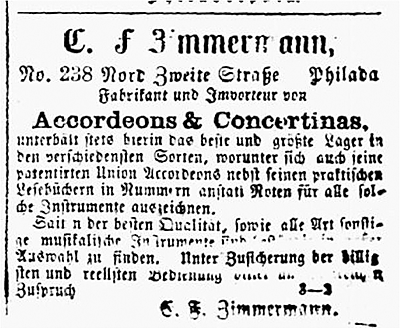
Figure 19. Concertina advertisement in New Jersey German language
newspaper Der Zeitgeist, 1870.
From online newspaper archives at www.genealogy.com.
English immigrants also brought and played concertinas, however they immigrated in much smaller numbers than
Irish and Germans in the late nineteenth century.
Many Mormon concertina players were first generation English immigrants, as was discussed
above. A number of English textile workers from Lancashire emigrated to New England in 1910, where they organized
an English-style concertina band in New Bedford Massachusetts. Its players played a variety of concertinas, among
them two and three row anglos of mostly English manufacture
(Figure 20).69
No other examples of concertina bands
are known in America, with the exception of numerous German and Czech Chemnitzer concertina polka bands.
Although inexpensive anglo concertinas have been built in Italy for the past thirty or more years, the issue of
whether Italian immigrants made extensive use of them is ambiguous. It was written in 1896 that in Philadelphia’s
‘Little Italy’ quarter, ‘every other house has a concertina or
accordion’.70 On a Chicago passenger railway car
in 1893, ‘in wandered a little Italian boy with a concertina … of his own accord he pulled the concertina out to
its widest extent and began ‘Tar-ra-ra Boom-de-ay’’.71
Finally, although the people described below are clearly not immigrants, it may be worth noting that in the 19th
century the popular anglo concertina reached all the way to the most remote settlements in North America, where
the native Aleut people hunted seal in southwestern Alaska. As noted by a visitor in 1886:
The great feminine solace in a well to do native hut is recourse to a concertina or accordion, as the case may
be. These instruments are especially adapted to the people. Their plaintive, slow measure, when fingered in
response to native tunes and old Slavonian ballads, always rise upon the ear in every Aleutian hamlet from
early morning until far into the night. The appreciation of good music is keen. Many of the women can easily
pick up strains from our own operas, and repeat them correctly after listening a short while to the traveler
or his wife playing and singing. They are most pleased with sad, wailing tunes, such as ‘Lorena’, the
‘Old Cabin Home’ and the like.
The church ‘prazniks’, or festivals, are very quiet affairs, but when the Aleut determines to celebrate his
birthday … he goes about it in full resolution to have a stirring and vociferous time. Therefore he brews a
potential beer by putting a quantity of sugar, flour, rice, and dried apples (if he can get the latter) into
a ten or twenty-gallon barrel, which is filled with water. He sends invitations out to his friends so dated
as to bring them to the barrabkie (sod house) when a right degree of fermentation in the kvass-barrel shall
have arrived; sometimes the odor of that barrel itself is sufficient to gather them in all on time. Some
one of the natives who is famous for natural and cultivated skill in playing the accordion or concertina,
is given the post of honor and the best of the beer; he or she, as the case may be, soon starts the most
hilarious dancing, because Aleuts are exceedingly fond of this amusement, especially when stimulated by beer.
If the amusement is large enough, the figures of an old Russian quadrille are gone through with, accompanied
by indescribable grimaces and grotesque side-shuffles of the dancers, the old women and young men being the
most demonstrative. Usually, however, a single waltzing couple has the floor at one time, whirling around
with the liveliest hop-waltz steps, and as it settles down out of breath, a fresh pair springs up from the
waiting and watching circle.72
Libby Beaman, the wife of a government agent on the remote Pribilof Islands in the Bering Sea, wrote of the
following Aleut Christmas in the islands’ tiny village, St. Paul, in 1879:
The dancing and festivities have been going on ever since Christmas. The first night after Christmas,
the school hall was thrown open for a masquerade dance. … The natives did all the most beautiful
Russian folk dances, which they have learned to execute with perfection …. As the week passed, more and more
clever maskers appeared in the streets and at the evening dances …. Last night, a few of the maskers
stopped at the house. They came with the two concertina players and the fiddler and danced for about
fifteen minutes for us, then went elsewhere.73
Anglo Use in the American Branch of the Salvation Army
The anglo concertina was in widespread use by the American branch of the Salvation Army in the latter part of
the nineteenth century. This movement, founded in 1865 in England by General William Booth, sought to save
working and lower class people from the despair of drunkenness, poverty and other urban plights by using
populist religion. Period reports frequently mention use of the concertina in their activities.
Eliza Shirley was a sixteen year old eager volunteer of the early SA in Coventry, England. When her father
Amos, a skilled silk weaver, was transferred to Philadelphia in 1880, she formed the first Salvation Army outpost
in the US in that city, ultimately enlisting both her parents. Her father played the anglo, like many SA members
at that time (Figure 21).
During the late 19th century, the anglo seems to have been the concertina of choice in the Salvation Army.
William Booth’s third son Herbert played the anglo (see below), as did second son Ballington, who was commandant
in the US during the period 1891-1896. In a meeting in Omaha in 1893,
Commander [Ballington] Booth then took out from a leather case that far-famed musical instrument, the concertina,
and with this accompaniment sang a hymn of his own composing, wonderfully sweet and touching. At first
many in the audience were inclined to indifference, but as the rich tones of his voice filled the church
with melody, the harshness of the instrument was forgotten in an endeavor to catch the words.
The refined sensibilitites of Commander Booth were made apparent when, as if in rebuke to those who
had at first been prone to criticize, he remarked in the words of David, ‘Let everything praise the Lord—even
the concertina.’74
General Booth’s daughter Evangeline (1865-1950) was at several times photographed with a Jeffries Anglo-Chromatic
instrument (Figure 22 and Figure 23).
Eva Booth was Commandant in the US for a short period during 1896, and returned
in 1904–34 as Territorial Commander; she became an American citizen during that time.
She had a flair for the dramatic in her evangelical work, as this report of a 1920s event demonstrates:
The glittering crowd at the Metropolitan Opera House included many of New York City’s elite. Now, as
rousing music stirred their souls, they sat expectantly. In the darkened auditorium, singers clad in
hooded robes of red and white mounted the stage and formed a huge crimson cross. The audience was ready,
more than ready—but for what? … As the anticipation mounted, a single shaft of blue
light caught a solitary figure heading down the center aisle. Dressed in tatters and rags, the homely
female form picked a tune on her concertina.
The costumed waif was Commander Evangeline Booth, head of the U.S. branch of the Salvation Army and
one of the few female denomination leaders in the 1920s. On this night, Booth was using New York’s
premier stage to present one of her acclaimed pageant-sermons … The Commander in Rags
… .75
Her popularity and that of Eliza Shirley seems to have helped draw many young women to the Army
ranks; Figure 24 shows Staff Captain Libby McCabe from Seattle, concertina in hand,
and Figure 25 shows a trio of American Salvation Army musicians, one with anglo concertina.
Much of the 19th century American (and English) press took a condescending, elitist tone when discussing the
movement and its working class followers. The concertina was often mentioned as a central part of the Army’s
musical activities; an example is this report of an 1888 gathering in New York City:
SATAN SCORED
By The Gory Heroes of the Salvation Army.
Blood Washed Warriors Make Converts and Noise in Everett Hall—An address by Commandant Booth.
Satan caught it hot and heavy at Everett Hall last night, and was seriously jumped upon and
maltreated by about seven hundred enthusiastic members of the Salvation Army persuasion, assembled
to welcome Commandant Herbert Booth [grandson of the founder]. … To the right sat Staff Captain Annie Reese,
cuddling a guitar, and Staff Captain Patty Watkins, nursing a tambourine. … The ceremonies opened with a
prayer by the marshal, who in conclusion called for all hands to shout aloud for salvation. Salvation was
accordingly shouted for to the tune of ‘While We Go Marching through Georgia’. … Commandant Herbert Booth
in nasal accent sang a hymn, accompanying himself with a concertina slightly out of tune, and
Adjutant MacFarlane … said some very unpleasant things about his
Satanic Majesty.76
In a stunt at an 1897 meeting, Adjutant J.C. Ludgate ‘attempted to break his previous record of singing
56 songs in 60 minutes’, accompanying himself on the concertina. ‘ “Now take a long breath and get your
handkerchief ready!” exclaimed the adjutant, picking up his concertina, “for when we’re well started
we can’t stop!” ’ Fifty eight minutes later, he had his record, and the acid-tongued comments of the reporter
were predictable:
What could be more irreverent or grotesque in a religious service than the spectacle of a leather-lunged
singer bawling ‘Come to Jesus’ at a rate of speed which would baffle the skill of the most expert
stenographer …. A few days ago Booth-Tucker’s Salvation Army barracks were branded as ‘a disorderly house’,
because all night religious services were marked by a volume of noise that rendered it impossible for
occupants of neighboring houses to sleep.77
A similar Los Angeles gathering met a similar response in an article entitled ‘The Noisy Nuisance Again
Out in Full Force’:
About seven o’clock they filed downstairs from their barracks … with flaming torches, banners flying,
big drum couchant, and concertina, anything but resonant. Immediately a crowd began to gather, and
the word went around that the ‘city [noise] ordinance did not stick’ …. The woman with the tambourine
shouted louder than usual, and the concertina was worked so violently that the noise of a wind instrument,
who carried the flag, was drowned out in the general babel of confusion …. According to the War Cry, there
were only 13 souls saved in Los Angeles during the past year. Considering the noise made by this band of
unmusical tramps it is surprising that there were so many saved.78
In Utah, Mormons were aware of the poor quality of the reception generally given the Salvation Army
by polite society elsewhere, as they had earlier experienced similar treatment:
Salvationists in New York are apparently about to undergo some of the adversities experienced by
the pioneer salvationists (the Mormons). A New York jury has found Booth-Tucker guilty of maintaining
a disorderly house because the lads and lassies of his hallelujah band disturb the peace of mind and
body of neighboring residents …. When a Salvationist gets warmed up to his spiritual work, the hallelujahs
reverberate with crescendo loudness, and accompanied by cymbals, drum, fiddle and concertina, make just
such a combination as Ogdenites lately have had the pleasure of listening to …. Could the sins of the
city’s debauching, carousing, chastity-destroying thousands be transmuted into sound, they would rise
to high Heaven from pits of hell … with the tremendous roar of a Kansas cyclone, to awe and put to rout
those whose ears are now so finely attuned to the commercial world as to be jarred by the clang of a
[Salvationist’s] cymbal …. 79
The loud, brash anglo concertina fit in well with the working classes that the Army sought to convert. As
a English Field Officer’s magazine put it, ‘It is not too much to say that a very large proportion of the
Officers whose Field service has been brought to an untimely end through throat and chest affections would
have been saved to the War had they taken the precaution of easing the strain on throat and lungs by learning
to play the concertina’.80
It was played in many open air gatherings, such as the tent meeting depicted in
Figure 26, Figure 27, and
(possibly) Figure 28,
in the US Midwest. The core group of musicians in the first two photographs
included three anglo concertinas as well as a banjo, violin, guitar, cornet,
and tambourine. In the photograph on the parade ground, the concertinas take the lead, with their immediate
band members following close behind. A brass band and a number of singers, hymn books in hand, round out the parade,
along with a two standard bearers, one of which is carrying a furled American flag.
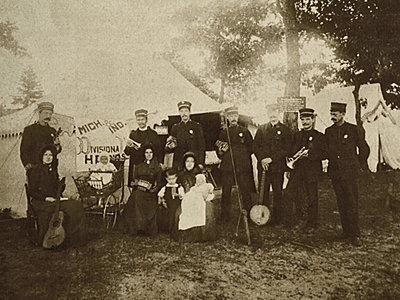
(Click to view a larger version of this picture.)
Figure 26. A group of musicians at a Salvation Army tent meeting, USA Midwest, ca. 1880.
Note the three anglo concertinists.
From the USA Central Division Historical Museum, Salvation Army, Des Plaines Illinois.
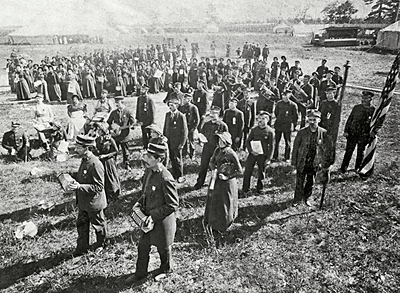
(Click to view a larger version of this picture.)
Figure 27. A parade at a Salvation Army tent meeting, with anglo concertinists leading the
musicians. USA Midwest, ca. 1880; the lead musicians are the same persons pictured in Figure 26.
From the USA Central Division Historical Museum, Salvation Army, Des Plaines Illinois.
In the 20th century, as the Army become more and more involved in high-price disaster relief operations, the
instrument of choice changed to the English system concertina, as this 1909 article pronounced:
‘No instrument is at the same time so portable, so powerful, cheap, and easily manipulated as a concertina—the
English type for preference, though the Anglo-German makes an excellent
substitute’.81 It may be that the English
system instrument was seen as more acceptable to the larger public the Army was now attempting to reach. In the
present day Salvation Army, neither is frequently played.
Early Twentieth Century: Decline and Near-Extinction
The popularity enjoyed by the anglo in 19th century America amongst immigrants, sailors, Mormon pioneers,
minstrel musicians, Salvationists and others was not to last. In the early twentieth century, sales and
usage of anglo and other concertinas in the US plummeted. Catalogs such as Montgomery Wards ceased carrying
the instruments, and very few new tutors were published. Newspaper classified ads of the period 1900-1920
included large numbers of ads for both Anglo-German and English concertinas that were being unloaded by their
owners, and few to no more advertisements appeared from musical instrument retailers selling new
ones.82
Public interest stories in newspapers that included the instrument became few and far between as public
interest dropped precipitously. The following bit of doggerel,
from a Bellevue Washington newspaper in 1914,83
shows that the reasons for its demise included both changing fashion, as well as the arrival of the
mass-produced piano:
Mine Own
My concertina sobs and shakes, for it’s in poor repair,
And neighbors say the noise it makes would cause the saints to swear.
My neighbors come, in protest bent, when on it I perform;
‘Why don’t you buy an instrument that’s up to date?’ they storm.
‘Pianos now are in the reach of e’en the poorest man,
And you might go and buy a peach on the installment plan.
Pipe organs too, on easy terms, are sold most everywhere;
Why play a thing that squeaks and squirms, and murders every air?’
‘Because,’ I answer, ‘‘tis mine own, all paid for, long ago;
And though it has a beastly tone, that fills the town with woe,
I’d rather hear its music sad, that keeps me in a sweat,
Than own the fairest, sweetest Strad, for which I’d gone in debt.
I’d rather it should make me sore with discords, every day,
Than have collectors at the door demanding instant pay.
The humble whistle, built of tin, by local plumber made,
Beats organ, flute or violin for which you haven’t paid.
My concertina seems a crime to folks like you, and yet,
I find that music most sublime which doesn’t hint of debt.’
Walt Mason
Still other reasons besides changing fashion and the arrival of other mass-produced instruments
seem to have played a part in the broad cessation in public interest in the anglo. Firstly, the effects
of the new Edison gramophone and the later Victrola, both invented in the US, were especially severe upon
amateur music in America. Sales of pianos and other instruments also drastically declined, as amateur
‘social orchestras’ were replaced by home use of professionally made recordings. A second, more damaging
cause was the abrupt and through-going change in American popular music itself. The immigrant ‘melting pot’
swelled in size and diversity towards the end of the nineteenth century, including large numbers of
people from middle and eastern Europe. Combined with the now-free and increasingly mobile
African-American population, these groups changed American popular music from a largely diatonic affair with
strong English, Irish and Scottish roots, to a more chromatic palette. Starting with Ragtime, and continuing
with Tin Pan Alley and Broadway melodies, Jazz, Rhythm and Blues, and extending into and beyond Rock and Roll,
American popular music frequently added notes not playable on a two row Anglo-German concertina (and
somewhat awkwardly
playable on a three row Anglo-Chromatic). American popular music and the little Anglo-German instrument had parted
ways, and the more chromatically able ukulele, guitar, and (for those who could afford it) piano
became the new champions of working class home musicians. This new, more chromatic popular music
originated in the US and then spread to other parts of the globe, so that the impact on the anglo
was felt first and hardest here. Small pockets of now-termed ‘traditional’ players survived in the rural west of
Ireland and in isolated parts of England, Australia, and South Africa. While England has recordings of
William Kimber and Scan Tester that reach back to the anglo’s heydays, Australia has Dooley Chapman among others,
and Ireland has its unbroken anglo tradition, the United States was left without a recorded legacy of its equally
long and rich nineteenth-century anglo musical experience.
Although Anglo playing had virtually died out in the US as a cohesive cultural phenomenon, the inexpensive
Anglo-German instruments were still carried by a few large general purpose music stores, much as they are
today. These instruments found their way into the hands of small numbers of isolated individual players in
the early part of the twentieth century. In New Jersey, a present day concertina player relates that,
‘My late father told me stories about his parents playing in the house when friends would come over.
On occasion he would be sent with a few dollars to go buy a new concertina, and a few quarts of beer,
and hurry back to help get ready for the guests. My late grandmother only played 2 row concertinas,
and a single row melodeon … . That was rural southern New Jersey in the 1920's’.84
Figure 29 shows a young girl in rural Kentucky in the 1920’s, cradling an Anglo-German instrument in what
may have been a ‘staged’ photograph in front of an iconic log cabin. Available documentary evidence,
in the form of a 2004 oral history study of musical families in the Virginia and North Carolina region,
shows that the concertina’s impact was non-existent in Appalachian Old-Time music in the early twentieth
century.85
Such living memories in today’s oral histories however do not reach back to minstrel time,
far back into the middle of the nineteenth century, when the anglo was indeed occasionally used in white
minstrel shows and by black string band musicians, as is discussed above. The girl’s parents in 1920,
who perhaps staged this photograph, would have had older memories from their own parents and grandparents,
who lived in the days of the minstrel shows.
Other than these tiny isolated remaining pockets of players, the only parts of the American public
continuing to play the Anglo in the early and middle twentieth century were a very few recently-arrived
anglo-playing Irish (and perhaps other) immigrants. County Westmeath native William Mullaly brought his
anglo concertina with him when he arrived from Ireland in 1910. His Columbia and Victor phonograph
recordings of 1926-27, made in Camden New Jersey, comprise the earliest known recordings of Irish music
on the anglo concertina.86
These are also perhaps the first recordings of any type made on the anglo;
earlier Edison cylinder and Victrola recordings feature English and Duet players. In similar fashion,
Father Charlie Coen emigrated to the US in 1955, and made several recordings of his native Irish music.
The Hollywood Anglo, and Arrival of Clowns and Girdles
After the anglo had passed out of American popular use, a brief review of a newly released silent movie
appeared in a 1921 Virginia newspaper:
A real old-fashioned barn dance with real old-fashioned music furnished by a mouth organ, concertina
and fiddler is one of the opening scenes in “Roads of Destiny”, a big new Goldwyn picture …. In the barn
dance, [the heroine] enters the throng, and laughs, jollies, and enjoys herself with the crowd of extras
as though she were actually living in the olden days when the barn dance with the old fashioned music and
surroundings was the regular nightly amusement …. The atmosphere of this new picture is
perfect.87
Thus began the use of the anglo concertina in popular Hollywood culture, as a stage prop to produce the
‘atmosphere’ of olden times. Although it had disappeared from the popular music scene, the little anglo
had made an impact upon popular memory and imagination that has long outlasted its music. Movie-makers
remembered that their grandparents had played them. In movies from the 1920s to the early 1960s, it appears
in the hands of sailors, or in covered wagons, or is played by star-crossed lovers (nearly always with an
accordion voice-over) whenever an “olden times” or especially affectionate setting was called for.
My Girl Tisa, a 1948 Warner Brothers release, was such a film, as Figure 30 illustrates.
It explored immigration issues in turn-of-the-century New York, and an anglo played by an old-timer added period atmosphere to a scene
in a ferry terminal.
The concertina (usually an anglo)
entered 20th century Hollywood culture as a cultural echo; people remembered that
they had been played half a century and more earlier. Just as modern Hawaiian movies are stereotypically
replete with ukuleles, celluloid sailors were commonly shown pumping the anglo.
An English concertina appeared in the 1956
version of Moby Dick despite never having been being mentioned in the original 1851 Herman Melville novel,
and
an anglo appeared in the hands of Bing Crosby as he crooned the hit song ‘True Love’ to Grace Kelly on a yacht
in the 1950’s High Society (Figure 31).
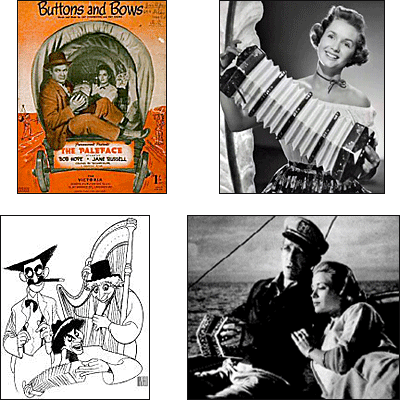
Figure 31. The anglo, as used in mid-twentieth century Hollywood.
Clockwise from upper left:
(1) Bob Hope on sheet music from The Paleface with Jane Russell (1948);
(2) Debbie Reynolds in a promotional photo for How the West Was Won (1962);
(3) Bing Crosby and Grace Kelly in High Society (1950);
(4) the Marx Brothers in an Al Hirschfeld drawing
(it is not known whether pianist Chico actually played the anglo concertina).
The anglo also appeared in many westerns. Along with its small size and homely appearance, it seemed to
mid-twentieth century movie audiences as somehow familiar and in sync with such ‘folksy’ situations. In 1952’s
The Big Sky, a French fur trapper is prominently shown playing an Anglo-German instrument, during an era
of American history fully thirty years before its invention. Figure 31
shows a Debbie Reynolds publicity
photo at the time of her 1962 movie How the West Was Won, where the concertina was used in a western
dance sequence during their covered wagon trip westward. Bob Hope is pictured carrying one inside a
covered wagon in 1948’s Paleface (also in Figure 31). None of these performers had the slightest
inkling of how to play it, but then neither did the audience. Nonetheless, they all had a vague shared
memory that perhaps that western setting might be right for an anglo … and as the above discussion
documents, these instruments really were played for dances that occurred in covered wagon days. Such
movie references became much less common toward the end of the twentieth century, as the cultural
echoes of the anglo faded from public memory.
The concertina echoed in other ways as well. Words like ‘concertina wire’ (starting during World War I),
‘concertina-pleated skirts’, and the Maidenform ‘concertina girdle’ (both in the 1950’s) evoked a shared
memory of the bellows function. At the same time, concertinas were resurrected by clown acts, often
using miniatures. In 1944, ‘Rolly Rolls the Musical Clown’ played ‘the world’s smallest concertina’
in a Dallas Texas event.88
In 1951, ‘Snookums blows tunes on a whistle and plays a
concertina’.89
Such
was the state of affairs of the once-popular anglo concertina in the US by mid-century.
The Anglo in the Concertina Revival in the US
A global resurgence of all things concertina was spurred on by the concertina ‘revival’ in England
in the 1970s,90
and by the concurrent global popularization of traditional music from Ireland. By this
time, usage of the instrument in its 19th century heyday in America had fully receded from living memory.
Cowboy singer Michael Murphey began to use an anglo in some of his western-style performances in 1973.
Most other American players who began playing it in the 1970s and 1980s, including the author, thought
of it as an Irish, English or even Gypsy folk instrument, not knowing that it had had a long history of
use within American popular culture. Accordingly, current anglo usage in the US is mostly connected with
various genres of European traditional dance music, of which Irish music is the most prevalent. Although
Irish emigration to the US had long since waned by the time of the ‘revival’, smaller numbers of Irish
immigrants such as Fr. Charlie Coen in New York and
Gearóid Ó hAllmhuráin in St. Louis continue to provide examples for growing numbers
of American enthusiasts (as does Chicago-born John Williams, a home-grown All-Ireland winner).
In similar fashion, English-born John Roberts and Tony Barrand perform English
traditional music in New England using anglo and English system concertinas.
A very few performers have sought to recreate an American style on the instrument. None of these musicians
have direct musical ties to the instrument’s nineteenth century heyday in America, but they are aware in
varying degrees of its earlier history. Bertram Levy is an old time banjo player who picked up the anglo
in the 1970s, utilizing it in several recorded albums of the 1980s. Sageflower Suite, with his friend
Frank Ferrel on fiddle, stuck to a mostly American palette, and First Generation explored American, Irish
and Eastern European genres. His popular anglo tutor of 1985, Demystifying the Anglo, was the first US tutor
since the nineteenth century to make extensive use of American tunes alongside more familiar Irish and English
fare. Jody Kruskal and his brother Tom Kruskal grew up in Chicago and play anglo in a chorded style
that Tom first learned from recordings of William Kimber.
Tom uses it for English morris dances and for contra dances in New England.
Brooklyn-based Jody also plays for contras, and has experimented with old time American music, releasing a CD of
this in 2007 (Poor Little Liza Jane). A concertina workshop in Palestine, Texas, has occurred for the last
several years within an old time music festival, and Jody taught workshop there in 2007 that featured
a re-created ‘old time’ style. Finally, John Townley produced a video instruction that attempted to emulate
English and American seagoing use of the anglo in the nineteenth century.
In the late 1990s, North American anglo concertina manufacture began in at least six US locations as well as an
additional one in Canada; these appear to be the only such instruments ever to have been built here.
All but three of these new manufacturers are building
accordion-reeded hybrid instruments. It is worth noting and perhaps somewhat ironic that the majority of
instruments played in this country in the 19th century were made in Germany and also had accordion-style reeds.
Of course, all this increased interest in anglo (and other) concertinas in the US mirrors similar growth of
interest in England, Ireland, Australia, South Africa, and elsewhere. Many other quality builders of anglo–style
concertinas have set up shop in the last thirty years in England, Ireland, the Netherlands, Australia, China,
Italy and South Africa, joining remaining traditional builders in England and Germany.
Part of this growth of interest in the anglo seems to be nostalgia for things ‘traditional’ and part is due
to the new global digital environment, where information is much more available for widely-scattered and
isolated players of now-‘fringe’ instruments like the anglo. However, the number of these current players
pales in comparison to the vast numbers of players a century and more ago … when the inexpensive German concertina,
one of the earliest affordable mass-produced consumer musical instruments, held a position in many working
class homes that is similar to that of the guitar or stereo system of today.
Resources
The heyday of the anglo concertina in the middle of the nineteenth century coincided with a period of
exceptionally high musical creativity within the United States that in turn coincided with the turbulence of the
Civil War and its lengthy aftermath. According to Patrick Sky, musician and American musicologist,
‘Songsters ‘sold by the truck loads’ …. The minstrel show had reached its popular zenith, and road shows of
every description were traveling all over the United States … a music boom took place in the middle of the
nineteenth century that included not only song and dance but also instrumental music and especially music
for the violin and banjo.’ 91
For those interested in playing this American music on the anglo concertina, the tutors and music collections of
Elias Howe are of central importance. His anglo tutors entitled Howe’s Western German Concertina School
and Howe’s Eclectic School for the Concertina (both 1879) are low on technique but high in content of popular
dances and minstrel songs of American origin, along with the more usual Irish and English dance tunes.
Although Alfred Sedgwick was indifferent to the anglo, he published some of the best 19th century tutors for it,
including Sedgwick’s Improved and Complete Instructions for the German Concertina of 1865. All of these tutors
are long out of print, but as part of the present paper’s release all are now available on the web at this website
(see Appendix below).
The musical content of the above early German concertina tutors may be unsatisfying to some however, because
the dance music they include is heavily tilted toward ‘military’ style dances that are not as fashionable today,
such as lancers, quadrilles, quicksteps, and galops. Elias Howe’s large late 19th century tune collections deleted
many of these tunes and concentrated on the reels, jigs and hornpipes that constitute most of the present American
repertoire. These collections include both Howe’s 1000 Jigs and Reels (1867), and the closely similar collection
published by his employee and business associate William Bradbury Ryan as Ryan’s Mammoth Fiddle Tunes (1882);
both were reprinted by Mel Bay Publications in the 1990s. Of the two, Ryan’s is still in print and is very
highly recommended as a signature repository of nineteenth century American traditional music. All of these tunes
were copied directly, without attribution, into the now out-of-print Cole’s 1000 Fiddle Tunes of 1940, itself
at one time considered the ‘Fiddler’s Bible’ of American traditional music. Howe was easily the most important
American collector of the nineteenth century, and these volumes contain hundreds of classic American-born tunes
amongst more to-be-expected Irish and English melodies.
Many of the credited American composers were active in minstrelsy, including Dan Emmett, Edwin Christie,
and Frank Livingston; minstrel groups seem to have played a lot of ‘traditional’ dance music. Many of the
settings are unusual, for example the ‘jigs’ in 2/4 time that are said to be the result of rhythm modifications
by clawhammer banjo players.92
Many tunes known in the Irish repertoire as hornpipes or polkas are shown in Howe’s/Ryan’s/Cole’s as reels, and
even those tunes shown as hornpipes are typically played by American fiddlers as reels (Figure 32).
The influence of these tunebooks has been enormous, not only upon American traditional music and the country
and blues genres that were to follow, but also on Irish music. Howe and Ryan collected over 600 Irish tunes,
more than any collector before Francis O’Neill. Several studies have concluded that about one in seven tunes
in O’Neill’s Music of Ireland (1903) was likely taken in a nearly unaltered form from Ryan’s (often with a slight
name change to a more Irish-sounding title).93
Such borrowing of tunes was standard practice amongst music publishers at the time.
The tunes in Howe’s/Ryan’s/Cole’sare typically in fiddle keys of G,D, and A, but in Howe’s German concertina tutors they are written in C and G,
which would have been the keys played by the groups that contained anglos in the nineteenth century. The fiddles
would tune down to the anglo, as the two-row Anglo-German instruments were mostly played in their ‘home keys’.
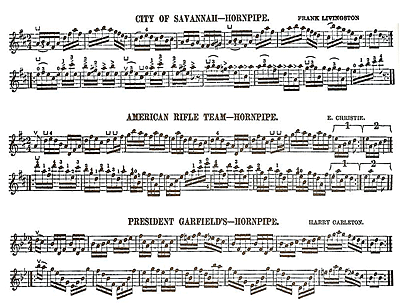
(Click to view a larger version of this picture.)
Figure 32. Three examples of American tunes from Ryan’s Mammoth Collection,
first published in 1882 and later reprinted as Cole’s 1000 Fiddle Tunes (1940)
and recently published again as Ryan’s by Mel Bay Publications (1995).
Frank Livingston played in the minstrelsy; Alistair Anderson recorded his City of Savannah.
The American Rifle Team was named in honor of a trio of international
victories by the team of that name in 1874-76.
President Garfield’s has crossed the Atlantic and was recorded by the Boys of the Lough.
Period accounts indicate that Salvation Army anglo players used their instruments mainly for chordal
accompaniment of songs. The pamphlet Instructions for the Salvation Army Concertina illustrates a non-melodic,
chorded approach to the anglo that was favored in the late nineteenth century; it too has been added to this
website (see Appendix). Finally, the music of the frontier Mormon settlers has been captured on a double CD of 1997
by the Beehive Band entitled Hymns, Songs and Fiddle Tunes of the Mormon Pioneers which contains some
concertina playing.
Appendix: Key Nineteenth Century Anglo Tutors in the United States
-
 Howe’s Western German Concertina School (1879)
Howe’s Western German Concertina School (1879)
-
by Elias Howe, Jr.
-
Elias Howe (1820–1895) was a prolific nineteenth century American publisher of
sheet music and tutors for a wide variety of popular instruments. This book has
a brief introduction to the German concertina keyed in C and G, but focuses on a
collection of American popular and patriotic songs, dances, operatic and Irish airs,
hymns, and Civil War era melodies. The hymns are largely taken from the shape note
tradition. Concertina tablature in the form of numbered buttons is found throughout.
The settings are typically simple, unaccompanied melodies; Howe seems to have simply
taken melodies from his vast collection of American tunes and transcribed them to
concertina-friendly keys.
Boston: Published and Sold by Elias Howe, 88 Court Street, 1879.
48pp. including covers.
-
Posted 15 April 2007
-
» read full document in pdf (or right-click to download)
-
 Howe’s Eclectic School for the Concertina (1879)
Howe’s Eclectic School for the Concertina (1879)
-
by Elias Howe, Jr.
-
Elias Howe (1820–1895) was a prolific nineteenth century publisher of sheet
music and tutors for a wide variety of popular instruments of his day. This book,
which is significantly lengthier than his “Western German Concertina School” tutor,
has a slightly more detailed introduction to playing the German concertina. This
introduction is written in both English and German, indicating that at least some
German-Americans were using the two row Anglo-German instrument. Like the “Western”
collection, it contains American popular and patriotic songs, dances, operatic and
Irish airs, hymns, and Civil War era melodies. Concertina tablature, in the form of
numbered buttons for an instrument keyed in C and G, is found throughout.
Boston: Published and Sold by Elias Howe, 88 Court Street, 1879.
In English and partly in German. 80pp. including covers.
-
Posted 15 April 2007
-
» read full document in pdf (or right-click to download)
-
 Sedgwick’s Improved and Complete Instructions for the German Concertina (1893)
Sedgwick’s Improved and Complete Instructions for the German Concertina (1893)
-
by Alfred B. Sedgwick
-
Alfred Blair Sedgwick (1821–1878) was an early music hall concertinist;
born in England, he migrated to the US ca. 1850. He much preferred the English system
over that of the German concertina, as his introductory notes to this tutor make clear,
but bowed to the popular preference for the latter instrument and prepared a number of
tutors for it. This tutor, one of his later and more complete ones, contains a lengthy
introduction to musical notation, as well as instruction tailored to the German concertina
with a set of progressive exercises. The tunes which follow are generally more demanding
than those of Howe’s books, and have been thoughtfully adapted to the anglo. Many have
simple harmonies and a few are challenging, fully harmonic pieces requiring a full
two-handed chorded treatment (see, for example, “Dodworth’s Lancers”). The tutor also
contains some concertina duets. Concertina tablature, in the form of numbered buttons
for an instrument keyed in C and G, is found throughout.
Boston: Published by Oliver Ditson & Co., 277 Washington Street, 1893.
80pp. plus covers and 1-page unnumbered insert. “Preliminary Remarks” dated from
“Brooklyn, L.I., January, 1865.”
-
Posted 15 April 2007
-
» read full document in pdf (or right-click to download)
-
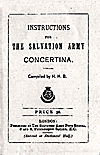 Instructions for the Salvation Army Concertina (1888)
Instructions for the Salvation Army Concertina (1888)
-
by Herbert H. Booth
-
The earliest known concertina tutor for the Salvation Army, compiled by Herbert H. Booth,
son of Salvation Army founder William Booth. This booklet is devoted exclusively to chording
on the Anglo concertina. The title’s phrase “Salvation Army concertina” refers to
an Ab/Eb concertina with 26 keys, the Salvation Army’s standard issue into the
twentieth century. The tutor provides I-IV-V chords (the “three chord trick”) for a number
of keys; the chords are shown as played with two hands without the melody,
presumably as an accompaniment for singing or for other instruments playing melody.
(Scan from Stephen Chambers, description by Randall C. Merris.)
London: Published by The Salvation Army Bookstores, 8 and 9, Paternoster Square, E.C., 1888.
Price 3d. 16pp. including covers.
-
Posted 15 April 2007
-
» read full document in pdf (or right-click to download)
Author
Dan Worrall
(
)
has played the Anglo and English concertinas for over thirty years, as an amateur hobbyist.
He is the author of The Anglo Concertina Music of William Kimber, published by the
English Folk Dance and Song Society in 2005,
and ‘David Edward Hughes: Concertinist and Inventor’, published in
Papers of the International Concertina Association, volume 4 (2007), as well as
a number of studies published on this site.
His current interests include studying various styles of Anglo playing as well as learning
the art of concertina construction. An earth scientist by training, he holds a Ph.D.
in geology from The University of Texas at Austin. He recently retired from a career
in petroleum exploration and research, and lives with his wife on a farm in the Brazos
River valley of southeastern Texas, where he raises cattle and is an avid gardener.
They have two children.

